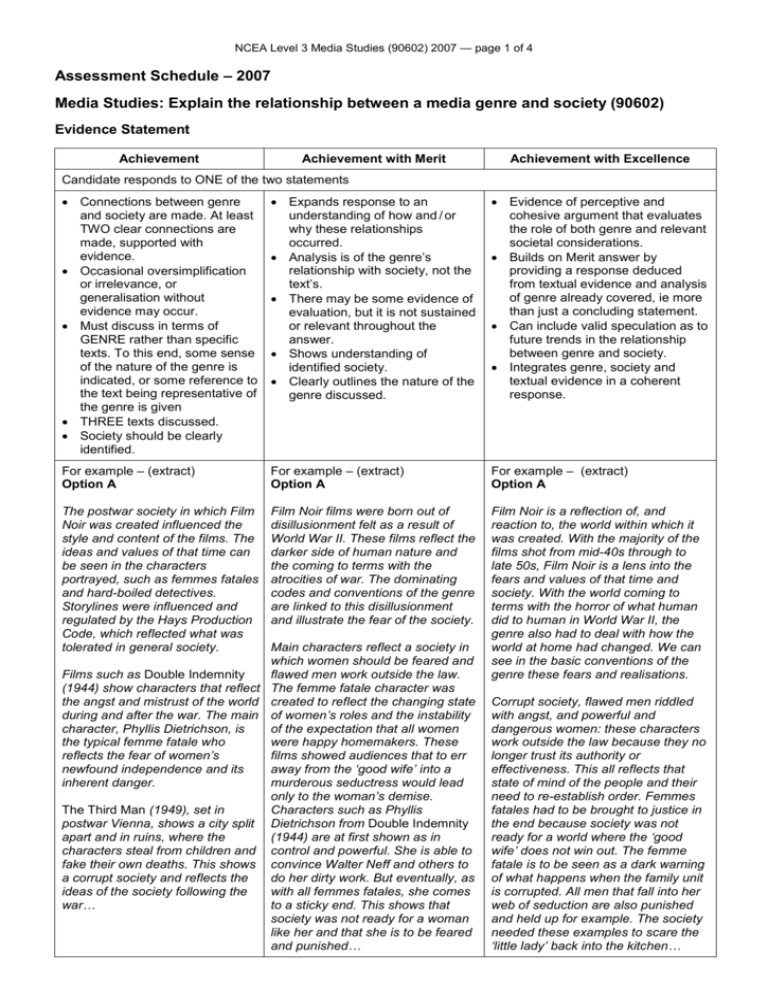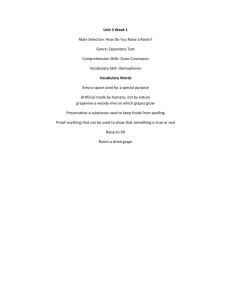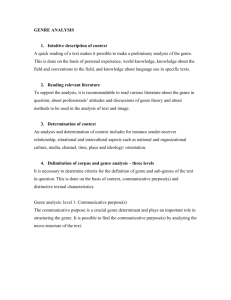2007 Assessment Schedule (90602)
advertisement

NCEA Level 3 Media Studies (90602) 2007 — page 1 of 4 Assessment Schedule – 2007 Media Studies: Explain the relationship between a media genre and society (90602) Evidence Statement Achievement Achievement with Merit Achievement with Excellence Candidate responds to ONE of the two statements Connections between genre and society are made. At least TWO clear connections are made, supported with evidence. Occasional oversimplification or irrelevance, or generalisation without evidence may occur. Must discuss in terms of GENRE rather than specific texts. To this end, some sense of the nature of the genre is indicated, or some reference to the text being representative of the genre is given THREE texts discussed. Society should be clearly identified. Expands response to an understanding of how and / or why these relationships occurred. Analysis is of the genre’s relationship with society, not the text’s. There may be some evidence of evaluation, but it is not sustained or relevant throughout the answer. Shows understanding of identified society. Clearly outlines the nature of the genre discussed. Evidence of perceptive and cohesive argument that evaluates the role of both genre and relevant societal considerations. Builds on Merit answer by providing a response deduced from textual evidence and analysis of genre already covered, ie more than just a concluding statement. Can include valid speculation as to future trends in the relationship between genre and society. Integrates genre, society and textual evidence in a coherent response. For example – (extract) Option A For example – (extract) Option A For example – (extract) Option A The postwar society in which Film Noir was created influenced the style and content of the films. The ideas and values of that time can be seen in the characters portrayed, such as femmes fatales and hard-boiled detectives. Storylines were influenced and regulated by the Hays Production Code, which reflected what was tolerated in general society. Film Noir films were born out of disillusionment felt as a result of World War II. These films reflect the darker side of human nature and the coming to terms with the atrocities of war. The dominating codes and conventions of the genre are linked to this disillusionment and illustrate the fear of the society. Film Noir is a reflection of, and reaction to, the world within which it was created. With the majority of the films shot from mid-40s through to late 50s, Film Noir is a lens into the fears and values of that time and society. With the world coming to terms with the horror of what human did to human in World War II, the genre also had to deal with how the world at home had changed. We can see in the basic conventions of the genre these fears and realisations. Main characters reflect a society in which women should be feared and Films such as Double Indemnity flawed men work outside the law. (1944) show characters that reflect The femme fatale character was the angst and mistrust of the world created to reflect the changing state during and after the war. The main of women’s roles and the instability character, Phyllis Dietrichson, is of the expectation that all women the typical femme fatale who were happy homemakers. These reflects the fear of women’s films showed audiences that to err newfound independence and its away from the ‘good wife’ into a inherent danger. murderous seductress would lead only to the woman’s demise. The Third Man (1949), set in Characters such as Phyllis postwar Vienna, shows a city split Dietrichson from Double Indemnity apart and in ruins, where the (1944) are at first shown as in characters steal from children and control and powerful. She is able to fake their own deaths. This shows convince Walter Neff and others to a corrupt society and reflects the do her dirty work. But eventually, as ideas of the society following the with all femmes fatales, she comes war… to a sticky end. This shows that society was not ready for a woman like her and that she is to be feared and punished… Corrupt society, flawed men riddled with angst, and powerful and dangerous women: these characters work outside the law because they no longer trust its authority or effectiveness. This all reflects that state of mind of the people and their need to re-establish order. Femmes fatales had to be brought to justice in the end because society was not ready for a world where the ‘good wife’ does not win out. The femme fatale is to be seen as a dark warning of what happens when the family unit is corrupted. All men that fall into her web of seduction are also punished and held up for example. The society needed these examples to scare the ‘little lady’ back into the kitchen… NCEA Level 3 Media Studies (90602) 2007 — page 2 of 4 Achievement Achievement with Merit Achievement with Excellence Phyllis Dietrichson from Double Indeminity (1944) is a classic example. She infiltrated her way into the Dietrichson family by winning the trust of Mr Dietrichson, murdering his ‘good’ wife, and then seducing him to secure her place as his wife. She is not comfortable with the role of wife and merely sees it as a means to securing her future and disposing of his daughter. This is the worst type of corruption because she is using the traditional role of wife and in some way making a mockery of it to manoeuvre into being a widow and inherit his fortune. Because of this, she must be punished; and she is. An audience of the time was not ready to have a woman like her in the role of wife. They needed to be reassured that women like her were not able to survive and prosper from their ‘evil’ ways. Human life as merely a casualty of crooked commerce also reflects the postwar disillusionment. In coming to terms with what we can do to each other in the war, the Film Noir films reflect society’s doubt in human nature and show a world where corruption is commonplace… For example – (extract) Option B For example – (extract) Option B For example – (extract) Option B The style and tastes of the time in which Film Noir was invented can be seen in the conventions of the genre; and as American society’s values and tastes altered, the genre has adapted and taken on aspects of the changing society. The Hays Production Code, pulp fiction novels, and postwar disillusionment all combined to invent the world of Film Noir. In this genre, we can see the style and tastes of the ’40s and ’50s. Modern Noir maintains the core structure but reinvents itself to reflect the modern world and attitudes. The style and tastes of the ’40s and ’50s can be seen in the way characters are presented and in storylines and worlds that are shown. The hard-boiled detective reflects the postwar flawed male and is drawn from characters from popular pulp fiction novels such as those by Raymond Chandler. The femme fatale reflects the danger perceived by a patriarchal society of the postwar woman, independent and desirable. Society has changed, and the style of woman has changed with it… Characters are portrayed to reflect society’s fears and desires. Innuendo is used to negotiate seduction under the radar of censorship. It was a corrupt world, and the storylines and characters reflect this. Characters’ innuendo and constant cigarette smoking take the audience into a trenchcoat world where dirty deeds lurk within labyrinth locations and femme fatales lie in wait. Film Noir was invented in a world suffering from postwar disillusionment and restricted by society’s fears and angst. The conventions of the genre are embedded in the style and tastes of the day they were created in; modern Noir has been able to reinvent itself to reflect a changing society while maintaining the core aspects of the genre. One way to measure reinvention is the portrayal of the femme fatale. Phyllis Dietrichson from Double Indemnity (1944) saturates the screen with her style of seduction and murder. She winds her way into Walter Neff’s confidence through suggestion and an anklet. The style of the day restricts her ability to win in the end and is destined to be punished and act as a warning… The distinct style of fast-paced dialogue riddled with innuendo was a device for filmmakers and characters that enables them to live in a world where dirty deeds and seduction ran rampant. Femmes fatales like Phyllis Dietrichson from Double Indemnity (1944) were able to seduce their prey with rapid dialogue… NCEA Level 3 Media Studies (90602) 2007 — page 3 of 4 Achievement Achievement with Merit Achievement with Excellence The femme fatale from early films such as Phyillis Dietrichson from Double Indemnity (1944) uses the style of innuendo to get her man. Modern femme fatales such as Wendy Kroy from The Last Seduction (1994) directly approach their targets… On the other hand, Wendy Kroy from The Last Seduction (1994) is free to bombard the screen with a directness that reflects changing attitudes toward women. She comes out on top in every element of the story and is ‘allowed’ to roam free to wreak havoc on a collection of unsuspecting males… In a particular scene at the beginning of their relationship, Phyllis and Walter Neff’s wordplay becomes so racy that she refers to him ‘breaking the speed limit’, something he is more than willing to do. She holds the power in the relationship from that start as she lets him speed to a certain level, then slows him down and directs how far he can go. This shows a woman who is confident with her sexuality enough to seduce and take control… However, Phyllis was restricted by how far she was able to go. The society was ready for her existence but not quite ready for her success. Her fate was always determined by society’s fear of the modern woman. Her confidence and control were allowed to exist only as a warning of what can happen when a woman takes control. She is destined to be put in her place permanently by being killed off. The reverse of this can be seen in the case of a modern Noir’s femme fatale, Wendy Kroy in The Last Seduction (1994). The taste of the day was for a modern woman to win. It was a world where girls can do anything, and Wendy is shown to do everything and get away with it. She does not bother with subtle wordplay and merely asks directly for what she wants and receives it. She seduces Mike to do her dirty work and kill her husband, Clay – something she has to do for herself because he is unable to do it. She then frames Mike for it. She gets away with everything – murdering Clay, setting up Mike – and then drives away with the money. She is from a society where the femme fatale woman does not need to be a warning, so she is allowed to exist and succeed… NCEA Level 3 Media Studies (90602) 2007 — page 4 of 4 Judgement Statement Evidence contributing to Achievement Evidence contributing to Achievement with Merit Evidence contributing to Achievement with Excellence Connections between genre and society are made. At least TWO clear connections are made, supported with evidence. Occasional oversimplification or irrelevance, or generalisation without evidence may occur. Must discuss in terms of GENRE rather than specific texts. To this end, some sense of the nature of the genre is indicated, or some reference to the text being representative of the genre is given THREE texts discussed. Society should be clearly identified. Expands response to an understanding of how and / or why these relationships occurred. Analysis is of the genre’s relationship with society, not the text’s. There may be some evidence of evaluation, but it is not sustained or relevant throughout the answer. Shows understanding of identified society. Clearly outlines the nature of the genre discussed Evidence of perceptive and cohesive argument that evaluates the role of both genre and relevant societal considerations. Builds on Merit answer by providing a response deduced from textual evidence and analysis of genre already covered, ie more than just a concluding statement. Can include valid speculation as to future trends in the relationship between genre and society. Integrates genre, society and textual evidence in a coherent response.








